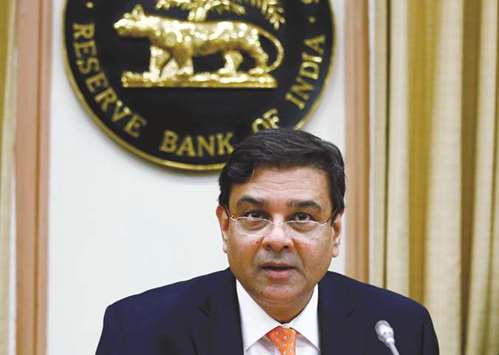The Reserve Bank of India kept its policy rate steady yesterday, as widely expected, after inflation accelerated to a seven-month high and stronger economic growth reduced the need for monetary stimulus.
All but two of 54 analysts in a Reuters poll had predicted the repo rate would be left unchanged for a second straight meeting at 6.00%, its lowest since November 2010.
The RBI also kept the reverse repo rate unchanged at 5.75%. The decision to stand pat was widely expected after the annual rate of consumer inflation increased in October to 3.58%, driven by higher food and crude oil prices.
That’s still low by Indian standards, but not far from the central bank’s 4% target.
Nonetheless, the RBI left its policy stance “neutral” while slightly softening its language on inflation by saying risks were “evenly balanced”. Many analysts believe the RBI will keep rates on hold in coming months, including at its next policy meeting in February, as it watches inflation trends.
“The global policy rate cycle and (rising) commodity prices, along with the consolidated fiscal position, will keep the RBI cautious,” said Suvodeep Rakshit, a senior economist with Kotak Institutional Equities in Mumbai.
Government officials have been calling on the RBI to cut rates given the economy, though recovering from July’s bumpy launch of a national sales tax, is not yet growing fast enough to create the jobs needed for India’s young workforce.
“We have a neutral stance, which means that depending on the data flow in coming months and quarters we’ll determine what we do regarding the policy,” RBI governor Urjit Patel told a news briefing after the decision.
“All possibilities are on the table, and we would look carefully at both the inflation data and growth data that comes in coming months.”
Five members of the Monetary Policy Committee (MPC) voted to keep rates unchanged, while one voted for a 25 basis point (bp) cut.
Indian bond prices have slumped in recent weeks as investors sharply pared expectations for rate cuts.
The central bank took advantage of an extraordinary period of low inflation, including a slump in food and energy prices, to cut rates by a total of 200 bps from January 2015 until August this year, when it last cut the repo by 25 bps.
But those factors are now reversing, with crude prices rallying and food prices expected to climb further.
Moreover, a growing number of global central banks, including most recently South Korea’s, are tightening policy, with the US Federal Reserve expected to hike rates again next week.
There is also growing uncertainty on whether the government will have to borrow more as it struggles to meet its fiscal deficit target, which could add to price pressures. Yesterday, the RBI slightly raised its inflation projection by 10 bps to between 4.3% and 4.7% in the six months ending in March 2018.
It also retained its projection for gross value added growth, a measure of economic expansion it prefers, at 6.7% for the year ending in March, the same as its forecast in October.
India’s economic growth rebounded to 6.3% in the three months ending in September, halting a five-quarter slide.
Bond markets took solace that the statement was not as hawkish as some had feared after the recent spike in inflation.
The yield on the benchmark 10-year bond yield slid 3 bps to 7.04% from around 7.07% before the policy decision.
It had risen more than 60 bps since the RBI’s August 2 policy meeting.
But the rupee weakened to 64.49 per dollar from around 64.47 before the RBI’s statement, while the broader NSE share index fell 0.7% for day, mostly before the rate announcement.
Sensex sheds over 200 points; rupee weakens
Bloomberg/Reuters
Mumbai
The BSE Sensex closed over 200 points lower and NSE Nifty fell below 10,050 points yesterday after the Reserve Bank of India (RBI) kept key rates unchanged.
The benchmark Sensex fell 0.63%, or 205.26 points, to 32597.18. So far this year, it has gained 23%.
All NSE indices, except IT, ended lower, with rate sensitive indices suffered most. PSU bank fell 2.10%, financial services 1.29%, auto 0.72% and realty 0.33%. Reliance Industries, Maruti and Hindustan Unilever were the top gainers, whereas Sun Pharma, SBI and ICICI Bank were major losers.
Meanwhile the rupee yesterday closed weaker against the US dollar after the Reserve Bank of India (RBI) kept key policy rates unchanged as it feared that inflation may top the central bank’s medium-term target of 4%.
The home currency ended at 64.52 a dollar, down 0.20% from its Tuesday’s close of 64.39. The rupee opened at 64.47 a dollar and touched a high and a low of 64.39 and 64.50, respectively.
The decision was in line with market expectations as most economists expected the central bank to keep the key repo rate — the rate at which it infuses liquidity in the banking system — unchanged at 6%. It also maintained its neutral policy stance. Noting several upside risks to inflation, RBI raised its fiscal second half inflation estimate range marginally to 4.3-4.7%.
The 10-year bond yield ended at 7.031%, compared to its previous close of 7.061%. Bond yields and prices move in opposite directions.
So far this year, the rupee has gained 5.5%, while foreign institutional investors have bought $8.75bn and $22.59bn in equity and debt, respectively.

Patel: Reiterating ‘neutral’ monetary policy stance.
